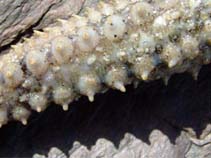Marthasterias glacialis (Linnaeus, 1758)
Spiny starfish| Native range | All suitable habitat | Point map | Year 2050 |

|
| This map was computer-generated and has not yet been reviewed. |
| Marthasterias glacialis AquaMaps Data sources: GBIF OBIS |
Classification / Names Common names | Synonyms | CoL | ITIS | WoRMS
Asteroidea | Forcipulatida | Asteriidae
Environment: milieu / climate zone / depth range / distribution range Ecology
Benthic; depth range 0 - 180 m (Ref. 106647). Subtropical; 71°N - 37°S, 32°W - 30°E
Distribution Countries | FAO areas | Ecosystems | Occurrences | Introductions
Atlantic and the Mediterranean Sea: north of Finland across the Mediterranean basin and the Adriatic Sea to the Guinean Gulf.
Length at first maturity / Size / Weight / Age
Maturity: Lm ? range ? - ? cm Max length : 70.0 cm WD male/unsexed; (Ref. 114120); 22 cm WD (female)
Life cycle and mating behavior Maturity | Reproduction | Spawning | Eggs | Fecundity | Larvae
Main reference
References | Coordinator | Collaborators
Koukouras, A. and M.-S. Kitsos 2010 Echinoderms. pp.288-296 In Coll, M., et al., 2010. The biodiversity of the Mediterranean Sea: estimates, patterns, and threats. PLoS ONE 5(8):36pp. (Ref. 85345)
IUCN Red List Status
(Ref. 130435: Version 2025-1)
CITES status (Ref. 108899)
CMS (Ref. 116361)
Threat to humans
Human uses
| FishSource |
Tools
More information
Max. ages / sizes
Length-weight rel.
Length-length rel.
Length-frequencies
Mass conversion
Abundance
Internet sources
BHL | BOLD Systems | CISTI | DiscoverLife | FAO(Publication : search) | Fishipedia | GenBank (genome, nucleotide) | GloBI | Gomexsi | Google Books | Google Scholar | Google | PubMed | Tree of Life | Wikipedia (Go, Search) | Zoological Record



